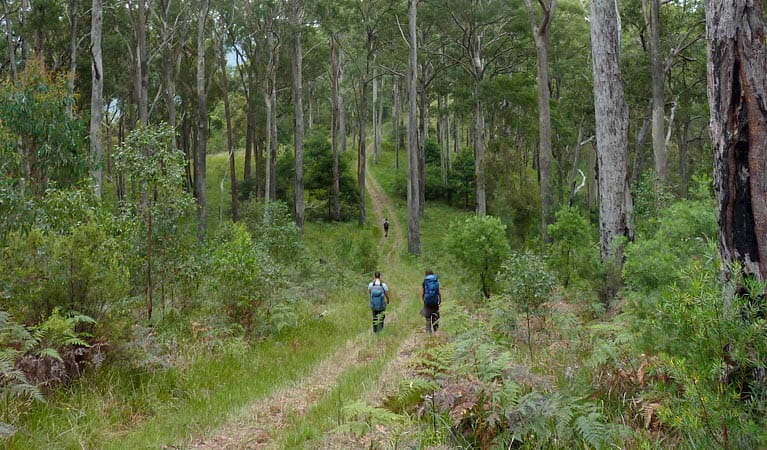The Green Gully track
North Coast, Country NSW
Overview
Make a booking to experience fern-lined gullies, high elevation forests and wildlife along the Green Gully track. Stay in heritage huts for a break from this challenging multi-day hike.
- Distance
- 65km loop
- Time suggested
- 4 - 5 days
- Grade
- Grade 5
- Price
-
Bookings include 2 to 4 hikers for 5 nights at $900. Additional hikers at $300 per person. Maximum 6 hikers per booking. You can’t walk the track alone.
- Bookings
- Book online. Select date of first night only and leave number of nights as default (1).Your booking starts at Cedar Creek Cottage, with the walk starting the next day.The track takes 4 days to complete. You'll be sent a confirmation with your track itinerary for 5 nights from your first date.
- Please note
- You will stay in 5 huts over your 4 day walk. Start at Cedar Creek Cottage followed by Birds Nest Hut, Green Gully Hut, Colwells Hut and finish up at Cedar Creek Lodge.
- You'll need to be fit and prepared for long, sometimes arduous walking over 4 days. The track is 65km and often steep, with a 900m descent on day 2, a walk through creek beds on day 3 and a 600m climb out on day 4.
- After you book, a comprehensive list of required gear and directions will be provided as part of your information pack.
- All people on the track must be over 12 years old.
- This park is in a remote location so please ensure you are thoroughly prepared, take appropriate clothing and equipment, and tell a family member or friend about your travel plans.
The Green Gully track, part of the World Heritage-listed Oxley Wild Rivers National Park, is an adventurous 65km walk. This award-winning walking track is one of the best in NSW, and takes you on a unique journey deep into the Apsley-Macleay gorges, one of the largest gorge systems in Australia.
The only way to experience the inspiring views, dramatic gorges and abundant wildlife is to book a self-guided walk.
On the four day Green Gully track, you’ll traverse fern-lined gullies, crystal-clear mountain streams, high-elevation forests as well as towering rocky outcrops. You’ll share some of the terrain with endangered brush-tailed rock wallabies, soaring wedge-tailed eagles, and native marsupial mice.
Uniquely, there is no need to carry a tent as you’ll stay in restored stockman huts along the way. Fitted with the essentials like beds, rainwater, solar-lighting, non-flush toilets and cooking equipment within each hut, these huts will greet the weary walker at the end of each day.
Local alerts
For the latest updates on fires, closures and other alerts in this area, see https://www.nationalparks.nsw.gov.au/things-to-do/walking-tracks/the-green-gully-track/local-alerts
Bookings
- National Parks Contact Centre
- 7am to 7pm daily
- 1300 072 757 (13000 PARKS) for the cost of a local call within Australia excluding mobiles
- parks.info@environment.nsw.gov.au
Park info
- in Oxley Wild Rivers National Park in the North Coast and Country NSW regions
Oxley Wild Rivers National Park is always open but may have to close at times due to poor weather or fire danger.
-
There are 3 areas in Oxley Wild Rivers National Park where you'll need day use vehicle permits: Halls Peak campground and picnic area, Riverside campground and picnic area, and Youdales Hut campground and picnic area. Day use vehicle permits can be bought online or by calling the National Parks Contact Centre on 1300 072 757. If camping, permit fees are included in the campground fee.
Contact us for permits.
- in Werrikimbe National Park in the North Coast and Country NSW regions
Werrikimbe National Park is always open but may have to close at times due to poor weather or fire danger.
Visitor info
All the practical information you need to know about The Green Gully track.
Track grading
Features of this track
Distance
65km loop
Time
4 - 5 days
Quality of markings
Sign posted
Experience required
Experienced bushwalkers
Gradient
Very steep and difficult
Steps
Occasional steps
Quality of path
Rough track, many obstacles
Getting there and parking
The Green Gully track is in the south eastern corner of Oxley Wild Rivers National Park. To get there:
- The track begins at Cedar Creek Cottage, 2hrs drive from Walcha, or 2½ hrs from Port Macquarie
- Detailed information on how to get there is provided when you book.
Navigation
After you book, you'll receive a robust pocket/folding map called a z-card to take with you that is more than adequate for navigating along the track. The map is very detailed and includes the route of the track, contours, grid references, emergency information, mobile coverage spots and locations of huts and trails. You won't need a topographical map.
While most of the track is on management trails, there are sections that are entirely off-track. You'll need skills in map reading, compass and GPS use, as the route is not maintained as a walking trail. At each trail or ridge junction, there are signs indicating which direction to go, but when walking along creeks, just follow the creek until you see a sign.
Cedar Creek Cottage access
You'll receive an access code in your booking confirmation email to access Cedar Creek Cottage on your first night.
Parking
While you’re on the track, your car is kept behind a locked gate at Cedar Creek. Your first night at Cedar Creek Cottage has undercover parking, but you'll need to move your car to Cedar Creek Lodge, 50m away and leave it in the open while you're on the track.
Best times to visit
There are lots of great things waiting for you in Oxley Wild Rivers National Park. Here are some of the highlights.
Autumn
A great time to tackle The Green Gully track when the days are not too hot and the nights not too cold.
Spring
The native trees and shrubs are a riot of colour, and the grass is still short - a perfect time to walk.
Summer
The creeks are a welcome sight for a cooling paddle after a long days walk, and the fireflies can make sleeping outside under the stars a real treat.
Winter
Crisp, cool and clear days are good for tackling the challenging terrain, but bring a good sleeping bag!
Facilities
Cedar Creek Cottage has 6 mattresses on old stretcher beds, a hot shower, flushing toilet, slow combustion wood fire, outside fire pit and paved area, basic kitchen with two gas burners, cutlery and crockery, large billy, large frying pan, large saucepan/rice cooker and coffee percolator, 6 camp chairs with side tables, a small 12 volt fridge/freezer, an outdoor gas barbecue, outdoor picnic table and undercover parking.
Birds Nest, Green Gully and Colwells Huts each have an outdoor picnic table and paved area, indoor and outdoor open fireplaces, 6 camping chairs, 6 stretcher beds with mattresses, a 2-burner gas ring and gas bottles, basic crockery and cutlery, large billy, large frying pan, large saucepan/rice cooker and coffee percolator, internal sink, and a pit toilet.
Green Gully Hut has the added bonus of a hot shower.
Cedar Creek Lodge has 10 mattresses on bunk beds in 3 bedrooms, a hot shower, flushing toilet, a slow combustion wood fire, outside fire pit and paved area, a fully equipped kitchen, including fridge (no freezer), gas oven, grill and stove, coffee percolator, cutlery and crockery, dining table and chairs, lounge chairs, an outdoor gas barbecue, outdoor picnic table, large verandah and emergency landline telephone.
Please note there are no bins along the track, so you’ll need to carry all rubbish to deposit in the bins provided in the final hut.
Toilets
- Flush toilets
- Non-flush toilets
Picnic tables
Barbecue facilities
Each hut has an internal fireplace and a fire pit outside. Fires are not permitted outside of these areas. Firewood is only provided between 1 April and 30 September, outside the bushfire period. Please use as little firewood as possible, it's an expensive item to replace in these remote locations.
We recommend that each group carry an emergency cooking device such as a small methylated spirit stove.
- Gas/electric barbecues (free)
- Fire rings (firewood supplied)
Drinking water
Each hut has a rainwater tank. We recommend that you boil all water or bring means of purifying the water before drinking.
Public phone
There is an emergency landline phone at Cedar Creek Lodge.
Showers
- Hot showers
Electric power
Cedar Creek Lodge has renewable 240 volt power, but cannot run devices drawing large currents such as toasters and hairdryers. The other huts have 12 volt solar power for lighting only.
Maps and downloads
Prohibited
Pets
Pets and domestic animals (other than certified assistance animals) are not permitted. Find out which regional parks allow dog walking and see the pets in parks policy for more information.
Smoking
NSW national parks are no smoking areas.
Learn more
The Green Gully track is in Oxley Wild Rivers National Park. Here are just some of the reasons why this park is special:
A national first
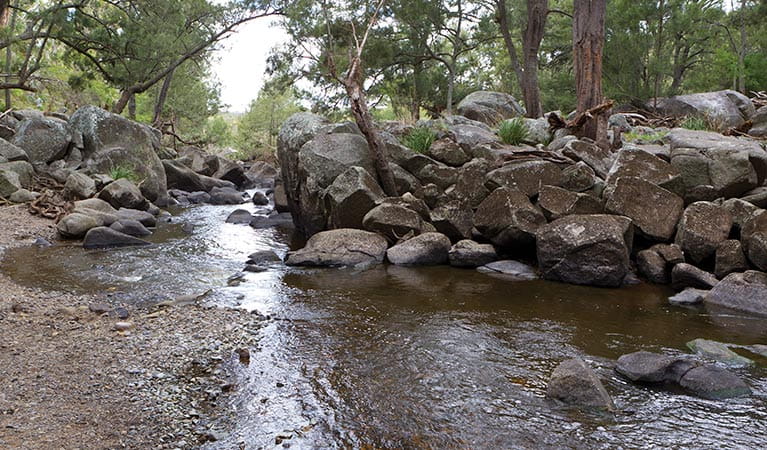
John Oxley was the first European to visit the New England region, passing through the area that is now Oxley Wild Rivers National Park in September 1818. Following Oxley, cedar-getters penetrated the remote and inaccessible gorges followed by pioneer cattle grazers who braved the remote wilderness for a hundred years. Between 1893 and 1894 the first commercial hydro-electric scheme was constructed to power the town and gold mines of nearby Hillgrove. Today you can visit the remains of this historical site when you take a walk along the Threlfall Historic walk.
- Threlfall walking track Threlfall walking track in Oxley Wild Rivers National Park takes in the spectacular Gara Gorge wilderness area, with scenic views and a chance to see the historic hydro-electric scheme.
Abundant wildlife
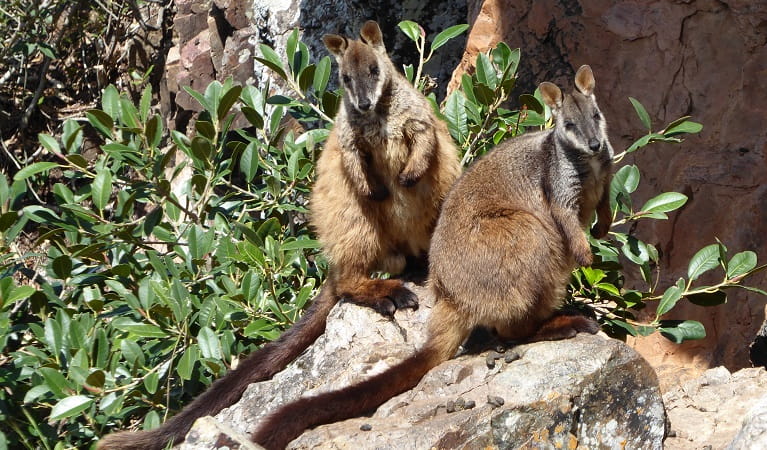
The varied plant communities of Oxley Wild Rivers National Park provide a home for over 350 animal species, including the largest confirmed population of brush-tailed rock wallabies. Even though there are roughly 10,000 of this endangered species in the park, you'll have to keep your eyes open to catch a glimpse of their bushy tail. The park also boasts over 173 bird species, including the majestic wedge-tailed eagle, peregrine falcon, square-tailed kite and sea eagle.
- Dangars Falls walking track Dangars Falls walking track is a great introduction to the waterfalls, rivers and gorges of Oxley Wild Rivers National Park, near Armidale. A short and easy stroll, it delivers you right into the heart of this vast World Heritage Area.
- The Green Gully track Make a booking to experience fern-lined gullies, high elevation forests and wildlife along the Green Gully track. Stay in heritage huts for a break from this challenging multi-day hike.
- Threlfall walking track Threlfall walking track in Oxley Wild Rivers National Park takes in the spectacular Gara Gorge wilderness area, with scenic views and a chance to see the historic hydro-electric scheme.
Ancient lands
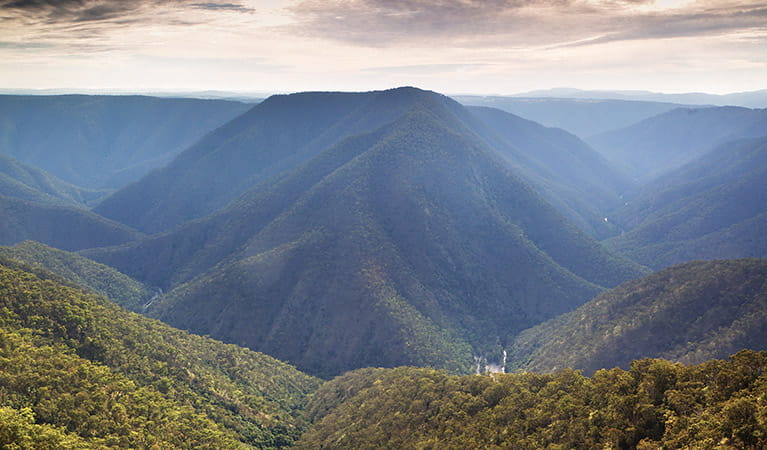
Oxley Wild Rivers National Park is part of the Gondwana Rainforests of Australia World Heritage Area. The park contains some of the best examples of dry rainforest communities in Australia. When you are out exploring the wet and dry eucalypt forests, grassy woodlands and heathlands of the park, look for native olives, lacebarks, shiny-leaved and giant stinging trees, shatterwoods, scentless rosewoods and red kamalas.
- Oxley Wild Rivers guided hiking adventures Explore one of Australia’s largest gorge systems on this multi-day guided trek with Primal Adventures. Experience lush gullies, waterfalls and stunning forests in World Heritage surrounds, near Armidale.
Jaw-dropping scenery
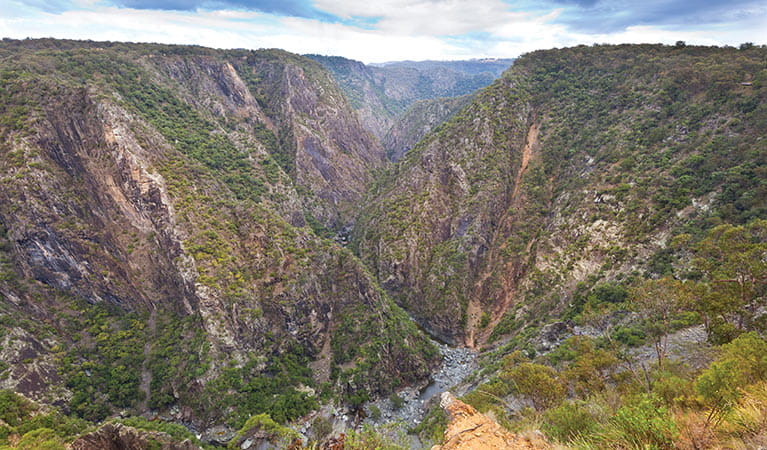
With dramatic ridges and gorges, towering rock outcrops and beautiful rivers and waterfalls, there is something new around every corner and you'll be constantly amazed by the views. The sight of a majestic wedge-tailed eagle soaring high above the gorges looking for food is a truly spectacular sight to behold. Don't forget your camera, give yourself plenty of time and keep your eyes open.
- Budds Mare lookout Enjoy a picnic lunch at Budds Mare lookout surrounded by World Heritage listed rainforest and looking out to spectacular views across the Apsley River.
- Dangars Falls walking track Dangars Falls walking track is a great introduction to the waterfalls, rivers and gorges of Oxley Wild Rivers National Park, near Armidale. A short and easy stroll, it delivers you right into the heart of this vast World Heritage Area.
- The Green Gully track Make a booking to experience fern-lined gullies, high elevation forests and wildlife along the Green Gully track. Stay in heritage huts for a break from this challenging multi-day hike.
- Tia Falls walk Tia Falls walk in Oxley Wild Rivers National Park is great for children. A short, easy walk, it offers spectacular views of Tia Falls and Gorge.
Plants and animals protected in this park
Animals
-

Swamp wallaby (Wallabia bicolor)
The swamp wallaby, also known as the black wallaby or black pademelon, lives in the dense understorey of rainforests, woodlands and dry sclerophyll forest along eastern Australia. This unique Australian macropod has a dark black-grey coat with a distinctive light-coloured cheek stripe.
-
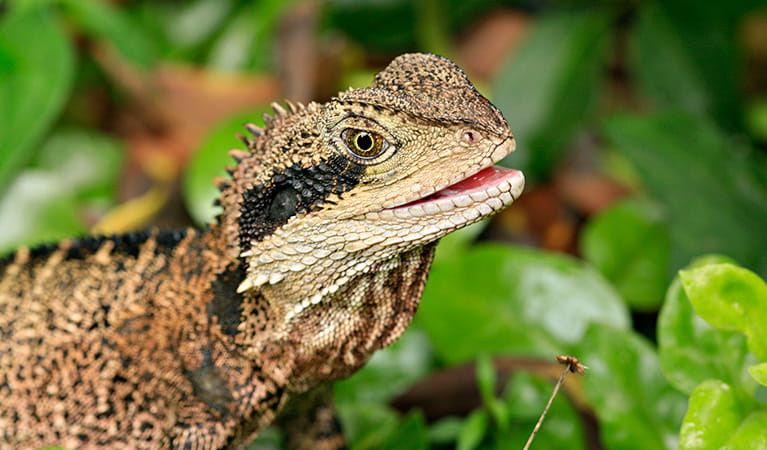
Eastern water dragon (Intellagama lesueurii lesueurii)
The eastern water dragon is a subaquatic lizard found in healthy waterways along eastern NSW, from Nowra to halfway up the Cape York Pensinsula. It’s believed to be one of the oldest of Australian reptiles, remaining virtually unchanged for over 20 million years.
-

Southern boobook (Ninox novaeseelandiae)
The southern boobook, also known as the mopoke, is the smallest and most common native owl in Australia. With a musical 'boo-book' call that echoes through forests and woodlands, the southern boobook is a great one to look out for while bird watching.
-
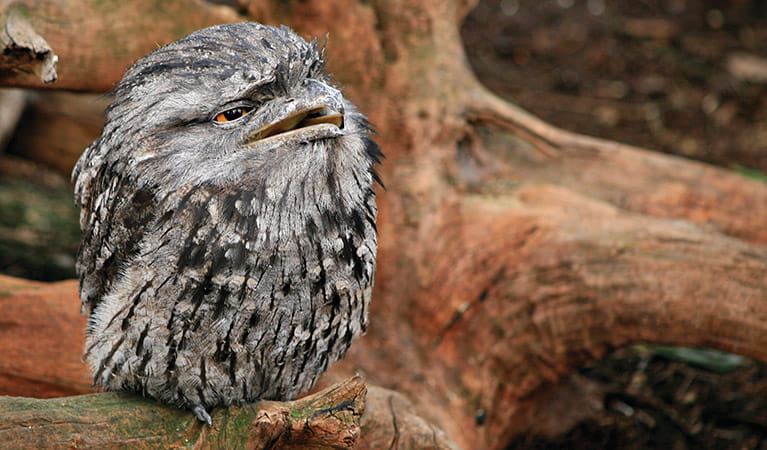
Tawny frogmouth (Podargus strigoides)
Found throughout Australia, the tawny frogmouth is often mistaken for an owl due to its wide, powerful beak, large head and nocturnal hunting habits. The ‘oom oom oom’ call of this native bird can be heard echoing throughout a range of habitats including heath, woodlands and urban areas.
-
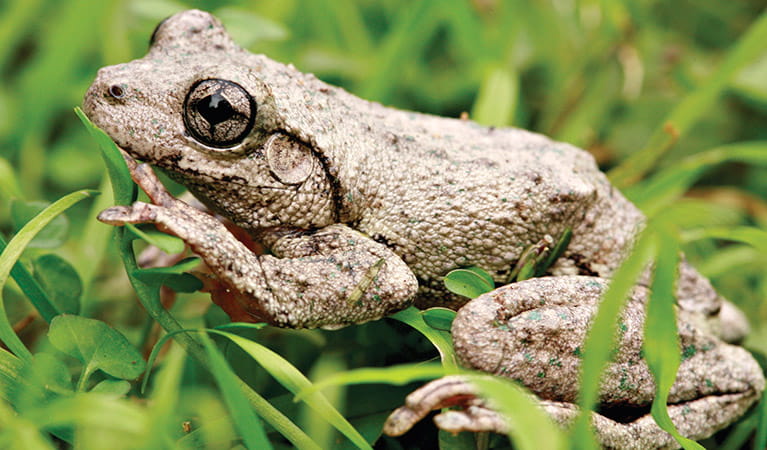
Peron's tree frog (Litoria peroni)
Peron’s tree frog is found right across NSW. These tree-climbing and ground-dwelling Australian animals can quickly change colour, ranging from pale green-grey by day, to a reddish brown with emerald green flecks at night. The male frog has a drill-like call, which has been described as a 'maniacal cackle’.
-
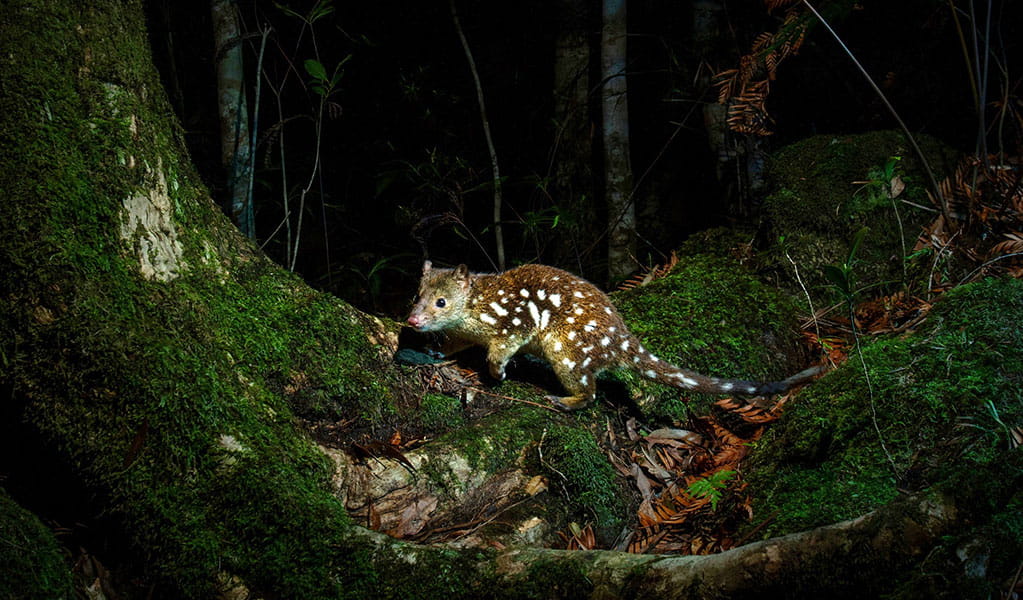
Spotted-tailed quoll (Dasyurus maculatus)
The spotted-tailed quoll is the largest remaining carnivorous marsupial on the Australian mainland. It’s protected as a vulnerable species in NSW.

